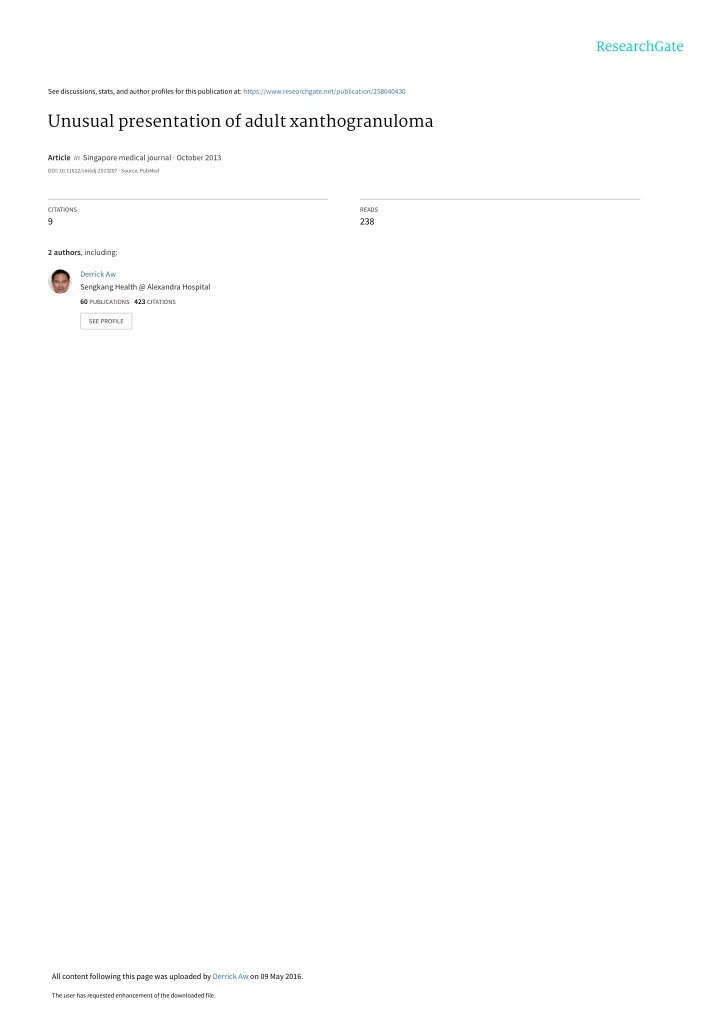

See discussions, stats, and author profiles for this publication at: https://www.researchgate.net/publication/258040430 Unusual presentation of adult xanthogranuloma Article in Singapore medical journal · October 2013 DOI: 10.11622/smedj.2013207 · Source: PubMed CITATIONS READS 9 238 2 authors , including: Derrick Aw Sengkang Health @ Alexandra Hospital 60 PUBLICATIONS 423 CITATIONS SEE PROFILE All content following this page was uploaded by Derrick Aw on 09 May 2016. The user has requested enhancement of the downloaded file.
Singapore Med J 2014; 55(2): e25-e27 C ase R eport doi: 10.11622/smedj.2013207 Unusual presentation of adult xanthogranuloma Lixian Chris Tan 1 , MBBS, Chen Wee Derrick Aw 1 , MBBS, MRCP ABSTRACT Xanthogranulomas are the most common form of non-Langerhans cell histiocytosis. Both adult and childhood forms have been described. Adult cutaneous forms can present as solitary or multiple yellowish, orange- red or tan-hued papules. Herein, we present the case of a 28-year-old Chinese man with a skin-coloured nodule on his left nasal ala that persisted for several months. While initial impression was that of a fibrous papule of the nose, the results of an excision biopsy showed histological features corresponding to xanthogranuloma. This case demonstrates the condition’s myriad of dermatological presentations, and adds to the differential diagnoses of a cutaneous lesion found in the head and neck region. Keywords: adult, adult orbital xanthogranulomatous disease, late onset, xanthogranuloma INTRODUCTION Classically, juvenile xanthogranuloma (JXG) is a disease that largely affects infants and children. Half of the cases of JXG have been reported in infants less than six months of age. (1) Approximately 10% of JXGs manifest in adulthood, and this form of JXG has been conveniently termed ‘late-onset JXG’ by some authors. (2) The present case report describes an unusual presentation of JXG in a 28-year-old man. CASE REPORT Fig. 1 Photograph shows a skin-coloured nodule on the A 28-year-old Chinese man presented with an asymptomatic, patient’s left nasal ala. gradually-enlarging nodule on his left nasal ala. The nodule had been described. (6) Resolution occurs spontaneously over a persisted for several months. Clinical examination revealed a period of months or years, leaving small atrophic scars. (3) Lesions 5-mm, well-demarcated, dome-shaped, skin-coloured nodule in adults have also been shown to regress spontaneously, on his left nasal ala (Fig. 1). Scaliness, telangiectasia and although this is uncommon. (7) central depression were absent. The lesion was firm in Extracutaneous involvement in JXG is recognised, and JXG consistency, and no other similar lesion was found elsewhere. involving the lung, liver, spleen, testes, pericardium, gastro- A diagnosis of benign fibrous papule was considered. intestinal tract, kidney, deeper soft tissues, eye and central Differential diagnoses included sebaceous adenoma, tricho- nervous system have been reported. (8) It is poorly understood epithelioma and trichoadenoma. whether adult forms are also associated with extracutaneous The patient underwent an excision biopsy of the entire involvement, with only anecdotal reports in the current literature lesion. Histopathological fjndings showed a tumorous dermal to suggest that the breast, (9) eye (10) and central nervous system (11) expansion composed of a mixed infiltrate of histiocytes, could be affected. In the aforementioned cases of suggested lymphocytes, eosinophils and neutrophils (Fig. 2a). Multi- extracutaneous involvement, the patients presented with breast nucleated giant histiocytes with wreath-shaped nuclei and lumps, nontraumatic iritis and hyphaema, and gait disturbances, foamy cytoplasm (i.e. Touton giant cells) were also seen (Fig. 2b). respectively. JXG has been observed in association with various diseases, DISCUSSION such as neurofibromatosis, Niemann-Pick disease, urticaria JXGs are benign tumours of histiocytic cells that spontaneously pigmentosa, chronic juvenile myelogenous leukaemia. (12) The regress. (3) The aetiology of this condition is still unknown. (4) JXGs prognosis of JXG is generally good due to its spontaneous generally start as asymptomatic reddish-yellow papules, which resolution. In 2009, Guo and Wang reviewed existing literature may enlarge up to 1 cm in diameter and evolve into yellow- on a heterogeneous group of conditions called adult orbital brown plaques. The lesions are firm and rubbery, and can xanthogranulomatous disease (AOXGD), which comprises four develop surface telangiectasia. Larger lesions (2–3 cm in size) subtypes. (13) It is unclear whether late-onset JXG represents one have been reported, (5) and ulceration and satellite lesions have 1 Division of Dermatology, National University Hospital, Singapore Correspondence : Dr Tan Lixian Chris, Registrar, Division of Dermatology, University Medicine Cluster, National University Hospital, 1E Kent Ridge Road, NUHS Tower Block, Level 10, Singapore 119228. chris_lixian_tan@nuhs.edu.sg e25
Recommend
More recommend